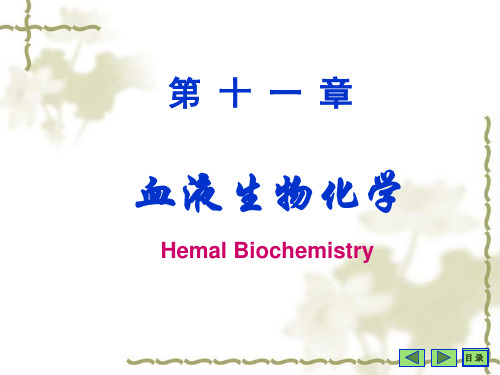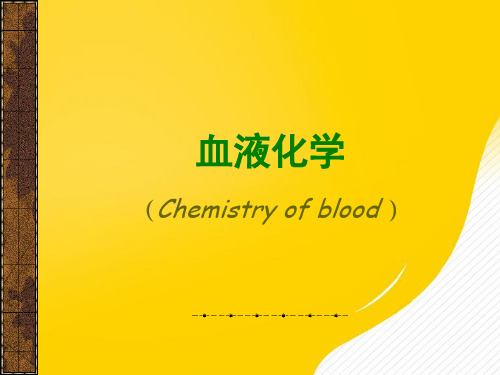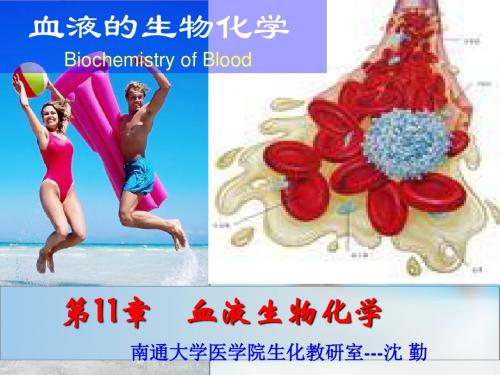生物化学血液生化资料
《生物化学》课件 第十三章血液的生物化学

二、血浆蛋白的功能
㈠ 维持血浆胶体渗透压 ㈡ 维持血浆正常的pH ㈢ 运输作用 ㈣ 免疫作用 ㈤ 催化作用 ㈥ 凝血、抗凝血和炎症反应 ㈦ 营养作用
第二节 血液凝固
概 念:
血管内皮损伤,血液与伤口接触或离 体血液与器皿等接触,使血液发生一系列 瀑布式的酶促连锁反应,血液由液体状态 转变为凝胶状态,称为血液凝固。
⑶、蛋白C抑制物与PC结合形成复合物 而灭活PC。
3、组织因子途径抑制物(TFPI) 组织因子途径抑制物是由血管内皮细 胞合成的糖蛋白,它直接抑制Ⅹa。
二、两条凝血途径
凝血因子Ⅹ被激活是使凝血 酶原激活的关键步骤,激活因子 Ⅹ有两条途径。
凝血途径
内源性凝血途径 外源性凝血途径
(一)内源性途径 1、概 念:
H2N
反应部位:胞液
O OH
N H
目录
3、 尿卟啉原与粪卟啉原的生成
4x 胆色素原 粪卟啉原Ⅲ
尿卟啉原Ⅰ 同合酶
尿卟啉原Ⅲ 脱羧酶
线状四吡咯
尿卟啉原Ⅲ 同合酶
尿卟啉原Ⅲ
反应部位:胞液
4、 血红素的生成
胞液中的粪卟啉原Ⅲ再进入线粒体
粪卟啉原Ⅲ 血红素
粪卟啉原Ⅲ 氧化脱羧酶
铅
(— )
亚铁螯合酶
Fe2+
原卟啉原Ⅸ
原卟啉原Ⅸ 氧化酶
原卟啉Ⅸ
反应部位:线粒体
目录
血红素合成的小结:
⑴ 合成的主要部位是骨髓和肝脏。 ⑵ 合成的原料简单:琥珀酰CoA、甘氨酸、
Fe2+ 等小分子物质。 ⑶ 合成的起始与最终在线粒体,中间在胞液。
⑷ 合成的限速酶是ALA合酶。
⑸ 铅抑制亚铁螯合酶、 ALA脱水酶的活性。
第11章血液生化(生物化学)

注: “+”,“-” 分别表示该途 径有或无 *晚幼红细胞 为“-”
目录
(一)糖代谢 1. 糖酵解和2, 3-二磷酸甘油酸(2, 3-BPG)旁路
2. 磷酸戊糖途径, 主要功能是产生NADPH+H+
目录
葡萄糖
二磷酸甘油酸变位酶
1, 3-BPG
3-磷酸甘 油酸激酶
目录
血液中的电解质则大部分为以离子状态存在的无 机盐
正离子有:Na+、K+、Ca2+、Mg2+; 负离子有:Cl-、HCO3-、HPO42-和SO42-; 血浆中Na+、Cl-的含量最多;细胞内则含K+、HPO42最多。 体液的电中性是由于各种体液内的正、负离子荷电总 量相等 在血浆中,Na+是维持血浆量和渗透压的主要离子; 在红细胞中,K+是维持细胞内液量和渗透压的主要离 子。 血浆中Na+、K+、Ca2+保持适当比例,维持着神经肌肉 的正常兴奋性。
因CO2形成的H2CO3,解离后使H+浓度增高,故CO2对O2饱和度 的影响在很大程度上是通过H+浓度的改变而实现的。 CO2和Hb结合成氨基甲酸血红蛋白时,也能解离出H+以影响Hb 对O2的亲和力。
2GSH
谷胱甘肽过 氧化物酶
H2O2
6-磷酸 葡萄糖酸
NADP++H+
GSSG
2H2O
目录
(二)脂 代 谢
成熟红细胞不能从头合成脂肪酸,通过主动 参入和被动交换不断的与血浆进行脂质交换, 维持其正常的脂类组成、结构和功能。
目录
《生物化学》第十四章

凝血酶
Ⅵ(Ⅴa) Ⅶa Ⅷa Ⅸa Ⅹa
血浆凝血活素前质
肝脏?网状内皮系统?
Ⅺa
接因子 纤维蛋白稳定因子
前激肽释放酶 高分子量激肽原
网状内皮系统? 肝脏? 肝脏
Ⅻa ⅩⅢa 激肽释放酶 缓激肽
功能
形成凝胶
蛋白酶 辅因子 辅因子 辅因子 蛋白酶 辅因子 蛋白酶 蛋白酶
蛋白酶
- 19 -
第二节 血液凝固
四、凝血作用的调节
凝血过程是一个级联放大的瀑布效应,加之 正反馈作用,可把最初生成的酶活性极大增 强。但血凝可造成心肌梗死、脑血栓等严重 疾病。因此,机体内的凝血作用必须保持适 度。
- 20 -
第二节 血液凝固
四、凝血作用的调节
血浆及血管内皮等处存在着多种抗凝物质,凝血过程中生成的纤维蛋白(抗凝血酶 Ⅰ)有 强烈吸附凝血酶的作用。血浆中抗凝血蛋白(抗凝血酶 Ⅲ)能与具有蛋白酶作用的凝血因 子以 1∶1 分子比结合形成复合物,从而封闭酶的活性中心。肝素能加速复合体的形成,使 抗凝血酶的活性提高数百倍。肝素是由肥大细胞和嗜碱性粒细胞产生的高分子酸性黏多糖, 是一种重要抗凝血物质,除上述作用外,它还能抑制血小板的黏附、集聚,从而影响血小 板磷脂的释放。肝素作为抗凝剂已广泛应用于临床。
内源性凝血的接触活化阶段
- 16 -
第二节 血液凝固
三、血液凝固的过程
(2)磷脂胶粒反应阶段
在 Ca2+ 的存在下,接触活化阶段产生的 Ⅺa 可使因子Ⅸ发生水解反应产生 Ⅸa。因子 Ⅸa 无酶活性,但可使因子Ⅹ的活化反应速度提 高 1 000 倍。Ⅹa 及凝血酶都有激活因子Ⅷ和Ⅴ 的作用。因子Ⅹa、Ⅴa 和 Ca2+ 结合在磷脂胶粒 上形成凝血酶原激活物。磷脂胶粒是由血小板提 供的富含丝氨酸磷脂的脂蛋白,对凝血因子和 Ca2+ 有较强的亲和力,从因子 Ⅺ 的活化到凝血 酶原激活物的生成一系列反应均在磷脂胶粒上进 行,故称为磷脂胶粒反应阶段。
血液的生物化学《生物化学》复习提要

血液的生物化学《生物化学》复习提要血液是人体中至关重要的流体组织,它在维持生命活动、运输物质、调节生理功能等方面发挥着不可或缺的作用。
要深入理解血液的生物化学特性,需要掌握一系列关键的知识点。
一、血液的组成成分血液由血浆和血细胞两部分组成。
血浆是血液中的液体部分,包含水、溶质和蛋白质等。
其中,水占血浆的绝大部分,是各种物质运输的介质。
溶质包括无机物和有机物,无机物如钠离子、氯离子、钾离子等,维持着血浆的渗透压和酸碱平衡;有机物则包括营养物质(如葡萄糖、氨基酸、脂质等)、代谢产物(如尿素、肌酐等)、激素和各种生物活性物质。
血细胞包括红细胞、白细胞和血小板。
红细胞的主要功能是运输氧气和二氧化碳,其内含血红蛋白,血红蛋白能与氧结合形成氧合血红蛋白。
白细胞在免疫防御中起着关键作用,可分为粒细胞(如中性粒细胞、嗜酸性粒细胞、嗜碱性粒细胞)、淋巴细胞和单核细胞。
血小板参与止血和凝血过程。
二、血液中的蛋白质血浆蛋白质种类繁多,具有多种重要功能。
白蛋白是血浆中含量最多的蛋白质,主要作用是维持血浆胶体渗透压,并作为载体运输各种物质。
球蛋白分为α、β和γ球蛋白,γ球蛋白即免疫球蛋白,参与机体的免疫反应。
纤维蛋白原在凝血过程中转变为纤维蛋白,形成血凝块。
血浆蛋白质的合成场所主要在肝脏,其含量和种类会因生理和病理状态而发生变化。
例如,在炎症或感染时,某些急性期蛋白的浓度会迅速升高。
三、血液的非蛋白含氮化合物血液中的非蛋白含氮化合物包括尿素、尿酸、肌酐、氨等。
其中,尿素是蛋白质代谢的主要终产物,通过肾脏排泄。
尿酸是嘌呤代谢的产物,浓度过高可能导致痛风。
肌酐反映了肌肉代谢和肾功能状况。
这些非蛋白含氮化合物的含量测定在临床上具有重要意义,可用于评估肾功能、诊断某些疾病以及监测治疗效果。
四、血液的缓冲系统血液具有维持酸碱平衡的能力,这主要依靠血液中的缓冲系统。
其中最重要的是碳酸氢盐缓冲系统,它由碳酸和碳酸氢根组成。
当体内酸性物质增多时,碳酸氢根与之结合,减少氢离子浓度;当碱性物质增多时,碳酸分解产生更多的氢离子,从而维持 pH 值的相对稳定。
血液生化

急性时相反应
三、几种血浆蛋白质
(一)前清蛋白 (二)清蛋白 (三)运铁蛋白(prealbumin,PA)
1、基本参数:分子量约54KD;肝细胞合成; 醋酸纤维素薄膜电泳位于清蛋白前;半衰 期很短,约12h;分子上有2个结合位点。 2、功能:1)营养:可作为组织修补的材料 2)运输载体:甲状腺激素;视黄 醇结合蛋白。
1、血红蛋白(Hb)特点 2、血红素的合成及调节 3、珠蛋白的合成 4、Hb的合成
1、Hb的特点 ① 一个Hb分子由4个珠蛋白亚基组成,每个 珠蛋白亚基含有一个血红素辅基。 ② 合成在红细胞成熟前完成
2、血红素的合成
① 部位:骨髓有核红细胞及网织红细胞;线
粒体、胞浆中合成。
② 原料:琥珀酰辅酶A,甘氨酸,Fe2+
3、血浆(plasma)、血清(serum):血清中 不含有纤维蛋白原 血浆=血清+纤维蛋白原
二、血液的基本成分
液体成分——水 固体成分 无机物:电解质 蛋白质
有机物: 含氮化合物
糖类
脂类
医学全在线
非蛋白类含 氮化合物
此外,还有一些微量物质如酶、激素、维生素等。
非蛋白氮(non-protein nitrogen,NPN)
三、血液的基本功能
(一)运输: O2、CO2、营养物质、代谢产物及 调节物 (二)维持内环境稳定:维持酸碱平衡;维持血 浆渗透压;参与体温调节 (三)免疫:白细胞、补体系统及免疫球蛋白等; 机体免疫系统的重要组成部分 (四)凝血、抗凝血
第二节 血浆蛋白质
一、血浆蛋白质的分类 二、血浆蛋白质的性质 三、几种血浆蛋白质 四、血浆蛋白质的功能
葡萄糖
DPG变位酶
1, 3-DPG
3-磷酸甘 油酸激酶
第篇血液生物化学优秀PPT资料

正常人血中NPN: 14.3~25.0mmol/L
临床意义:反映蛋白质、核酸的代谢情况 及肾脏的排泄功能
血液中尿素氮(blood urea nitrogen, BUN) 约占NPN的1/2
临床意义:判断肾脏排泄功能的指标
意义:供能、2,3-BPG支路、氧化还原系统
1. 糖酵解
获得能量的唯一途径 ATP:
维持膜上离子泵的正常功能 脂质的更新 谷胱甘肽和NAD+的生物合成
2. 2,3-BPG支路
红细胞糖酵解途径中,由1,3-二磷酸甘油 酸(1,3-BPG)经2,3-BPG转变为3-磷酸 甘油酸的侧支途径,称为2,3-BPG支路
磷酸戊 6-磷酸葡萄糖
糖途径
脱氢酶
谷胱甘肽 还原酶
谷胱甘肽 过氧化物酶
6-PGA
NADPH+H+ GSSG
蚕豆病
2H2O
二、血红蛋白的合成 与调节
血红蛋白 hemoglobin
正常成人:HbA(α2β2)
珠蛋白
血红素
heme
氧化还原系统
还原力
NADH(糖醛酸途径)
MHbHb
NADPH(磷酸戊糖途径)
二、血浆蛋白的共同特点
大部分在肝脏合成(其他: 球蛋白) 合成场所— 附在内质网上的多核蛋白体 大多数属于分泌性蛋白质 绝大多数是糖蛋白(清蛋白例外) 许多血浆蛋白呈多态性 具有特征的t1/2(半寿期)
三、血浆蛋白的功能
1. 维持血浆胶体渗透压—清蛋白(75%~80%) 2. 维持血液正常pH值 3. 营养作用—清蛋白 4. 运输作用 5. 催化作用 6. 血液凝固和纤维蛋白溶解作用 7. 防御作用
血液的生物化学4h

止血与凝血
血小板能够快速到达受损部位并 发挥作用,促进血液从液态转变 为凝固态,止血和修复损伤。
调节体温
血液中的白细胞和激素等物质 能够调节体温,维持人体正常
温度范围。
02
血红蛋白与氧气运输
血红蛋白的结构
由四条肽链组成,呈 环形结构,每个肽链 都结合一个血红素辅 基。
血红蛋白的不同变体 (如珠蛋白和肌红蛋 白)在结构上略有差 异。
血红素辅基包含铁原 子,是血红蛋白运输 氧的关键部分。
血红蛋白与氧的结合
血红蛋白与氧结合的过程是可 逆的,受氧气分压的影响。
当血液流经肺部时,血红蛋白 与氧结合,形成氧合血红蛋白, 将氧气从肺部运输到身体其他 部位。
血红蛋白与氧的亲和力受pH值 和2,3-二磷酸甘油酸的影响。
血红蛋白与二氧化碳的结合
呼吸调节主要通过调节二氧化碳的排出量来维持酸碱平衡,当体内酸性 物质增多时,呼吸加深加快,排出更多的二氧化碳,降低血液中的酸度。
肾脏调节主要通过调节尿液的酸碱度和排泄量来维持酸碱平衡,当体内 酸性物质增多时,肾脏会加强碳酸氢盐的排泄,同时减少酸性物质的排 泄,反之亦然。
05
血液中的其他重要物质
血脂
血液的生物化学4h
目录
• 血液的组成和功能 • 血红蛋白与氧气运输 • 血糖的代谢与调节 • 酸碱平衡与血液缓冲系统 • 血液中的其他重要物质
01
血液的组成和功能
血液的组成
血细胞
包括红细胞、白细胞和血小板, 分别具有不同的形态和功能。
白细胞
主要负责免疫功能,包括吞噬 细菌、病毒和其他外来物质。
维生素
维生素是维持人体正常生理功能所 必需的微量营养素,参与多种生化 反应和代谢过程。
11.血液生化

•红细胞中,K+是维持细胞内液量和渗透压的主要离子
•Na+、K+、Ca2+保持比例维持神经肌肉的正常兴奋性
正离子有:Na+、K+、Ca2+、Mg2+ Fe2+等,
负离子有:Cl-、HCO3- 、 SO42-、 HPO42-
二、血浆蛋白质
(一)血浆蛋白质的组成和特性 血浆蛋白质的组成:
血浆中各种蛋白质的总称
6、铅中毒,铅抑制ALA脱水酶和铁螯合酶。
(三) 铁的来源
男性体内铁总量: 3~4g,女性偏低
Hb铁占60~70%
Mb铁占4%
体内储存铁主要以铁蛋白和含铁血黄素形式存在
铁代谢
铁的摄取与 排泄 铁的吸收 食物 红细胞释放
胃黏膜脱落、皮肤落屑、 泌尿道失铁等
胃肠道内,吸收率10% (酸性条件有利);主要在十 二指肠及空肠吸收。
按 功 能 分 类
6. 血浆蛋白(酶及)酶抑制剂 都是糖蛋白,功能是抑制血浆中的各种酶、补体成分等等, 对体内一些重要的生理过程起调节作用。 7. 载体蛋白
①结合、运输 ②提供特异的微区环境 ③生理增溶剂的作用 ④具有解毒和帮助排泄的作用 ⑤对组织细胞摄取,被运输物质起调节作用
血浆中还存在一些未知功能的血浆蛋白质。
生 理 意 义:
2 3 4
5
(二) 2,3-BPG支路
在红细胞中: 变位酶的活性
>
磷酸酶的活性
红细胞内2,3-BPG浓度几乎与Hb相等
2,3-BPG功能: 和Hb相互作用影响Hb 对氧的 亲和力,调节Hb的带氧功能。
该支路的生理意义在于:
(1)ALA合成
线粒体内
ALA (2)卟胆原生成 2 ALA
生化课件第十六章血液生化

2020/10/20
第一节 血 浆 蛋 白 Plasma ProteinБайду номын сангаас
血浆蛋白是维持体内代谢的重要物质
吉林大学白求恩医学院 杨成君
5
2020/10/20
一、血浆蛋白的分类与性质
血浆蛋白指血浆含有的蛋白质,是血浆中的主要的固体成分
血浆蛋白总浓度:70~75g/L
血浆蛋白的种类多,含量也不相同 通常按来源、分离方法和生理功能将血浆蛋白质
分类。 分离蛋白质的常用方法包括
电泳(electrophoresis):血浆蛋白质 超速离心(ultra centrifuge):血浆脂蛋白
吉林大学白求恩医学院 杨成君
6
2020/10/20
(一)血浆蛋白的分类
电泳(electrophoresis)
是最常用的分离蛋白质的方法,常据此分类
清蛋白(albumin) 1球蛋白(1 –globulin) 2球蛋白( 2 –globulin )
多种疾病导致血浆蛋白异常
风湿病
急性炎症反应和抗原刺激引起免疫系统增强,特征:
免疫球蛋白升高:特别是IgA,可有IgG和IgM升高 炎症期可有α1-AG、Hp、C3升高
肝脏疾病
急性炎症反应和抗原刺激引起免疫系统增强,特征
免疫球蛋白升高:特别是IgA,可有IgG和IgM升高? 炎症期可有α1-AG、Hp、C3升高?
外分泌酶:外分泌腺分泌的酶
消化系统的蛋白酶、淀粉酶、酯酶 脏器受损时血浆含量增加,有助于临床诊断
细胞酶:存在于组织细胞内参与代谢的酶类
正常情况血浆含量甚微,小部分有器官特异性,用于诊断。
吉林大学白求恩医学院 杨成君
18
2020/10/20
生物化学-血液生化

18
(二)血液凝固的途径 血液凝固有内源性和外源性两条不同的途径, 它们的区别在于启动方式和参加的凝血因子 不同 。X因子活化后两条途径则使用共同的 通路,凝血酶原活化成凝血酶,最后将纤维 蛋白原转变为纤维蛋白。
19
1.内源性途径
血液在受损的血管内膜或在血管外与异物表 面接触而触发的凝血过程,即内源性途径 (intrinsic pathway)。参与该途径的凝血因子 全部存在于血浆中。
第二十章 血液生物化学
Blood Biochemistry
1
血液是循环于心血管系统中的流动组织,具有黏滞 性。血液与淋巴液、组织间液一起组成细胞外 液,是体液的重要部分。
血液的组成 血浆(plasma)
红细胞、白细胞、血小板等
常用血液样品:
全血=血浆+有形成分(加抗凝剂)
血浆=全血-有形成分(加抗凝剂,离心,取上清)
37
二、纤维蛋白溶解
• 纤维蛋白溶酶原(简称纤溶酶原, Plasminogen)被纤溶酶原激活剂活化成纤溶 酶(Plasmin),纤溶酶水解血凝块中的纤维 蛋白而使血凝块溶解。
38
• 纤溶酶原是肝合成的含790氨基酸残基的单链糖蛋白, 血浆中浓度为1.5~2.0mol/L,半寿期约5分钟。纤 溶酶原在组织纤溶酶原激活物(tissue plasminogen activator, t-PA)的作用下,激活生成纤溶酶。纤溶 酶水解纤维蛋白中由精氨酸和赖氨酸残基的羧基形成 的肽键,使纤维蛋白凝块溶解 。
(前加速因子) 330 000
肝
5.0~10
12~36
Ⅶ
稳定因子
50 000
肝
0.56~8
Ⅷ 抗血友病球蛋白330 000 肝、内皮细胞
生物化学基础第13章 血液的生物化学

生物化学基础第13章血液的生物化学血液,是生命的河流,在我们的身体内不停地流淌,为各个器官和组织输送着养分和氧气,同时带走代谢废物。
这看似平常的红色液体,其实蕴含着极其复杂而精妙的生物化学奥秘。
血液由血浆和血细胞组成。
血浆是血液中的液体部分,其中包含了大量的水以及各种溶质,比如蛋白质、糖类、脂类、无机盐、代谢产物和激素等。
这些溶质在维持血液的渗透压、酸碱平衡以及运输各种物质方面发挥着至关重要的作用。
蛋白质是血浆中含量最多的溶质之一。
血浆蛋白主要包括白蛋白、球蛋白和纤维蛋白原。
白蛋白是维持血浆胶体渗透压的关键,它能够吸引水分留在血管内,防止血液中的水分过多地渗透到组织间隙中,导致水肿。
球蛋白则在免疫反应中起着重要作用,例如抗体就是一种特殊的球蛋白,能够识别和抵御外来病原体的入侵。
纤维蛋白原在血液凝固过程中扮演着重要角色,当血管受损时,它会被激活转化为纤维蛋白,形成血凝块,以阻止血液继续流失。
除了蛋白质,血浆中还含有各种糖类和脂类物质。
血糖是人体能量供应的重要来源,其浓度需要保持在相对稳定的范围内。
而血脂则包括胆固醇、甘油三酯等,它们的代谢异常可能会导致心血管疾病的发生。
血细胞包括红细胞、白细胞和血小板。
红细胞中含有血红蛋白,这是一种能够结合和运输氧气的蛋白质。
血红蛋白由珠蛋白和血红素组成,血红素中的铁离子与氧气结合,使得红细胞能够在肺部摄取氧气,并将其输送到身体的各个部位。
当红细胞数量减少或血红蛋白功能异常时,就会出现贫血症状,导致人体缺氧,影响正常的生理功能。
白细胞在免疫系统中发挥着关键作用。
它们分为粒细胞、淋巴细胞和单核细胞等多种类型。
粒细胞能够吞噬病原体,淋巴细胞则参与特异性免疫反应,包括细胞免疫和体液免疫。
当身体受到感染时,白细胞的数量会增加,以对抗病原体的入侵。
血小板在止血和凝血过程中起着不可或缺的作用。
当血管受损时,血小板会迅速聚集在损伤部位,形成血小板栓子,并释放一系列的生物活性物质,促进血液凝固。
- 1、下载文档前请自行甄别文档内容的完整性,平台不提供额外的编辑、内容补充、找答案等附加服务。
- 2、"仅部分预览"的文档,不可在线预览部分如存在完整性等问题,可反馈申请退款(可完整预览的文档不适用该条件!)。
- 3、如文档侵犯您的权益,请联系客服反馈,我们会尽快为您处理(人工客服工作时间:9:00-18:30)。
血 液又将细胞代谢产生的CO2运送到肺,将其它代谢终产物运送到肾 液 脏等排泄器官而排出体外。
的 血液具有缓冲功能
功
它含有多种缓冲物质,可缓冲进入血液的酸性或碱性物质引起
能 的血浆pH变化。
血液中的水分有较高的比热,有利于体温的相对恒定。
血液具有重要的防御和保护的功能。
参与机体的生理性止血、抵抗细菌、病毒等微生物引起的感染 和各种免疫反应。
16
Overview of protein sorting In mammalian cells, the initial sorting of proteins to the ER (内质网) takes place while translation is in progress. Proteins synthesized on free ribosomes(游离核糖体) either remain in the cytosol(细胞液) or are transported to the nucleus(核), mitochondria(线粒体), chloroplasts (叶绿体), or peroxisomes(过氧化物酶体). In contrast, proteins synthesized on membrane-bound ribosomes are translocated into the ER while their translation is in progress. They may be either retained within the ER or transported to the Golgi apparatus(高尔基复合体) and, from there, to lysosomes(溶酶体), the plasma membrane (细胞膜), or the cell exterior via secretory vesicles(分泌 小泡)
血浆蛋白 清蛋白、脂蛋白、运铁蛋白、铜蓝蛋白等 IgG ,IgM ,IgA ,IgD ,IgE 和补体C1-9 等 凝血因子Ⅶ、Ⅷ、凝血酶原、纤溶酶原等 卵磷脂∶胆固醇酰基转移酶等 1抗胰蛋白酶、 2巨球蛋白等 促红细胞生成素、胰岛素等 C-反应蛋白、 2酸性糖蛋白等
14
血浆蛋白质的性质
第三篇
➢绝大多数在肝脏合成,少数由其它组织细胞合成。
11
血浆的化学组成 血浆蛋白质的分类、性质和功能 血细胞代醋 速酸 离纤 心维
素 薄 膜 电 泳
清蛋白 α1球蛋白 α2球蛋白 β球蛋白 γ球蛋白
13
血浆蛋白按功能分类
种类 1.载体蛋白 2.免疫防御系统蛋白 3.凝血和纤溶蛋白 4.酶 5.蛋白酶抑制剂 6.激素 7.参与炎症应答的蛋白
专题篇
血液生物化学 肝胆生物化学 细胞信号转导 癌基因、抑癌基因与生长因子
1
专题篇
血液生物化学 肝胆生物化学 细胞信号转导 癌基因、抑癌基因与生长因子
2
血 液 在 封 闭 的 血 管 内 循 环
3
4
运输是血液的基本功能。
血液将从肺获取的O2及从肠道吸收的营养物质运送到各器官、 细胞,将内分泌腺产生的激素运输到相应的靶细胞;另一方面,血
➢合成场所一般位于膜结合的多核糖体上,从粗面内质网到高尔基复
合体到质膜而分泌入血液。
➢除清蛋白外,几乎所有的血浆蛋白都为糖蛋白。 ➢许多血浆蛋白呈现多态性。 ➢在循环过程中每种血浆蛋白均有自己特异的半衰期。
➢炎症或组织损伤时某些血浆蛋白水平会升高——急性时相蛋白质。
15
Overview of protein sorting
17
Cotranslational targeting of secretory proteins to the ER Step 1: As the signal sequence emerges from the ribosome, it is recognized and bound by the signal recognition particle (SRP). Step 2: The SRP escorts the complex to the ER membrane, where it binds to the SRP receptor. Step 3: The SRP is released, the ribosome binds to a membrane translocation complex of Sec61 proteins, and the signal sequence is inserted into a membrane channel. Step 4: Translation resumes, and the growing polypeptide chain is translocated across the membrane. Step 5: Cleavage of the signal sequence by signal peptidase releases the polypeptide into the lumen of the ER.
8
血浆的化学组成 血浆蛋白质的分类、性质和功能 血细胞代谢特征 血液凝固
9
血浆的化学组成
液体成分——水 (77-81%)
固体成分
无机物:电解质 有机物: 含氮化合物
糖类 脂类
蛋白质
非蛋白类含氮化合物 (尿素,氨……)
10
血浆(plasma)、血清(serum): 血清中不含有纤维蛋白原 血浆=血清+纤维蛋白原
很多疾病可导致血液的成分或性质发生特征性变化。
5
组血 成液 的是 流由 体血 组浆 织和
血 血液 细 胞
血细胞 血浆
红细胞 白细胞 血小板
淋巴细胞 单核细胞 粒细胞
嗜中性 嗜酸性 嗜碱性
6
抗凝剂 3000rpm,30min
血浆 白细胞 血小板 红细胞
7
All of the cells found in the blood come from bone marrow.
